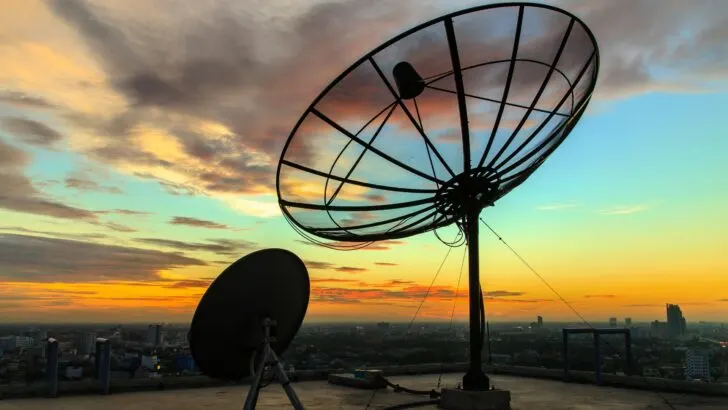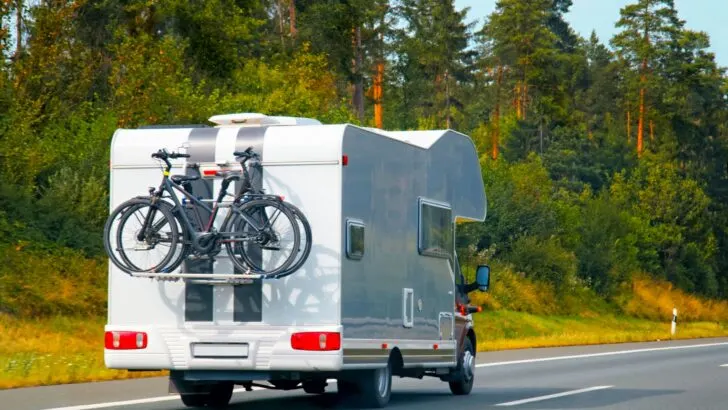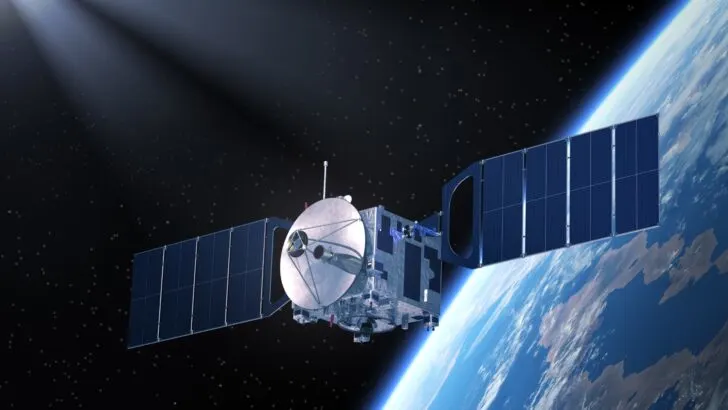If you need reliable portable internet service when you’re traveling, there are a number of different ways to go. You can take a look at our post on our RV internet solutionsto see what we do to stay connected as we live and work on the road full time. But in today’s post, we’re taking a look at portable satellite internet as a means of staying connected while you travel.
This is an option that’s growing in both availability and popularity, especially with the arrival of Starlink on the mobile satellite internet scene.
So, today we’re looking at three of the top options for portable satellite internet.
Let’s get right to it!
What Is Portable Satellite Internet?
We’re all familiar with internet services provided by cell towers, cables that tether us to broadband connections, and wireless internet. But satellite internet is a whole different ballgame.
Satellite internet is wireless internet, but it’s beamed down from satellites that orbit the Earth.
The way it works is that an internet provider sends a signal to a satellite in space. That internet signal comes to you (the subscriber) via some form of satellite terminal, most commonly a small satellite dish.
The satellite dish is connected to a modem, and your modem connects your computer, mobile hotspot, or other devices to the internet signal (either hardwired via Ethernet or by providing a Wi-Fi signal that wireless devices can connect to).
The portable aspect is the part that allows you to travel and have internet service via satellite wherever you go.
This is accomplished using portable hardware, namely a satellite dish mounted on your RV or on a tripod. The hardware travels with you wherever you go, and the wireless internet signals are beamed down to that hardware (wherever you travel) from the satellites orbiting the Earth.
Are All Satellite Dishes the Same?
No. Satellite dishes vary in size and type.

Satellite dishes vary in size and type, and RV satellite dishes are often different from home or stationary satellite dishes.
Some satellite dishes are mounted on your RV and can be folded down when your rig is underway. This is generally accomplished electronically from inside the cabin.
There are also smaller satellite dishes that are operated manually. They usually sit on a stand or tripod. You may need to move the entire stand/tripod and dish around to seek a better internet connection, though some tripods allow for the dish to be repositioned.
It’s important to know that in general, the larger the satellite dish, the larger the area of the sky that’s covered and the better the quality of incoming internet you’ll receive. This is simpler, of course, when you’re using a large dish attached to a stationary house, for example.
In this case, you’d have a residential satellite internet plan and your house would be connected to a large-ish satellite dish, likely mounted to the roof of your home or on a large stand in an open area with a clear, treeless view of the sky.
However, the satellite internet available at your home isn’t mobile and won’t be available to you when you’re traveling. It can only provide an internet connection to you in your home where your location stays the same.
With portable/mobile satellite internet, whenever you deploy or set out your satellite dish, your new location coordinates must be obtained for the dish to properly be aimed so it can establish a connection. This makes matters more complicated.
What Are My Best Options for Satellite Internet In My RV?
At present, there are limited options available for having full satellite internet in your RV. Please note that we’re NOT talking about satellite TV here. There are a number of additional options for television (not covered in this article).

Satellite internet is not just for television. Many people work on the road or need internet access to stay connected.
We’re referring specifically to full portable internet solutions for travelers. Fortunately, the few options available are good ones, and are getting better all the time.
Internet speeds vary for each of these options, so if you’re a traveler who works on the road (or who does a lot of video streaming), you’ll want to choose the portable satellite internet option that offers the right balance of speed and cost for your needs.
Let’s take a look at the three most popular options for RV portable satellite internet…
Starlink RV
Starlink RV is the latest (and arguably the greatest) portable satellite internet provider on the scene. Of the three options we’re laying out in this post, Starlink RV offers the best price and the best speed…two things we think most users are interested in.
Starlink currently has the world’s largest constellation of satellites. And their Starlink RV plan allows RVers to access high-speed, low-latency internet at any time… from any destination where Starlink provides active coverage.
To see Starlink’s current coverage map, click here and then mouse over the area(s) that interest you. As you mouse over the map, where you see areas noted as “High Capacity”, Starlink says you can expect high-speed, low-latency internet. In areas noted as “Low Capacity”, you’ll notice considerably slower speeds, especially during hours of peak usage.
For Starlink’s RV services you’ll pay a one-time hardware cost of $599, and then $135/month for your portable satellite internet service. The service can be turned on/off at any time and there is no contract.
Perhaps even more interesting to RVers, Starlink now offers a new “Flat High Performance” system for in-motion use, but it’s only available in certain areas (contact Starlink for more information). In-motion use is portable satellite internet while your RV is actually moving down the road, not just when you’re stationary and have manually deployed your satellite dish.

Starlink is now providing satellite internet “on the go”, as you roll on down the road. Starlink calls this in-motion internet “Flat High Performance” and it’s currently only available in certain markets.
Note that this service does not use the same hardware as your regular Starlink RV plan. The hardware for in-motion use is a flat-mounted dish permanently installed on the roof of your RV. The dish is durable even in harsh weather conditions. Brace yourself, though… the cost for this equipment is a $2,500 one-time fee.
But again – it’s only available in select markets at this time, so be sure to check.
Perhaps the one downside to Starlink RV (though it may not be different from any other provider) is that mobile plans (i.e. the Starlink RV plan) get de-prioritized relative to stationary residential StarLink customers in heavily congested areas. So, if your travels take you to a location with a high density of active Starlink users with a residential plan, your internet speeds may be reduced during peak usage periods.
HughesNet and Viasat
These next two satellite internet providers are popular with RVers as well, but they work a bit differently than Starlink does.
Although they’re two of the three most popular satellite internet providers for RVers, neither of these providers offers specific support for portable use of their product.
To use a plan from either of these providers, you’ll need to purchase equipment from resellers (like MobilSat or RF Mogul, as opposed to from the providers themselves) and then install the equipment yourself (or hire an installer) and move it around as needed to get the best reception.
Neither provider directly offers support for RV installations or for mobile use, as their services are targeted to residential and business users.
Also with these two providers, every time you move your RV, you’ll have to point your satellite dish in the best direction for reception at each new location.
You can access HughesNet or Viasat satellite internet when your RV is stationary in a campground or RV park, but for every new location, you’ll need to re-aim your dish (a website like DishPointer can be helpful). In some cases, that will mean manually setting up a tripod and orienting the dish correctly. In other cases, it will simply mean pressing a button on control hardware and allowing the dish to automatically point itself. It depends on the provider and your hardware budget.

A satellite orbiting Earth.
HughesNet
HughesNet is a satellite internet provider powered by a couple of high-capacity satellites known as EchoStar XIX and EchoStar XVII.
With HughesNet, you’ll get speeds comparable to broadband speed as well as data options that are available (according to HughesNet) even in remote locations.
All HughesNet plans come with 25 Mbps of download speed and 3 Mbps of upload speed, though these advertised speeds are not guaranteed and are subject to slowing based on a number of factors.
The plans offered by HughesNet range in data from 16GB ($65) up to 100 GB ($175) per month, although there are new-customer deals on some plans.
You’ll choose the number of GBs you and your family require per month and pay for that amount. Should you go over the number of allotted GBs in your plan, you’ll remain connected but at reduced speeds until the next billing cycle.
Viasat
Another popular provider of satellite internet is Viasat.
Their speeds range between 12 Mbps and 100 Mbps, but all packages have data caps.
Caps vary from 40 GB to 300 GB per month, and cost varies accordingly ($50 – $200/month). If you exceed your data cap, you’ll likely experience reduced speeds, just as with HughesNet.
Viasat does have extensive coverage and all plans include a 2-year price lock.
Do You Use Portable Satellite Internet in Your RV?
If you use portable satellite internet on the road, we’d love to hear about your experience! Drop us a comment and let us know what provider or providers you’ve used and how it’s worked out for you!
Or if you’re interested in what the best solution is for your internet connectivity needs while on the road, read our article: “Best Internet For RV Use? There’s No One-Size-Fits-All Answer!”
Geek Out With Us Every Week
Join our newsletter to learn about all things RV-related. Every week we offer free tips, tricks, product reviews, and more to our online community of RVers. So, whether this is your first time on the road or you’re a seasoned expert, we’d love for you to geek out with us!


Anthony Barbieri
Monday 20th of November 2023
I have been using star link since mid june. I received my equipment in 2 days and set it up in 10 minutes. I never shut it down. I put it in stow mode using my star link phone app. I store it in a case. Travel to my next rv park and have it set up and watching tv in less than two minutes. No wire to the tv. If you travel enough with it and pay attention to the orientation of the dish. You can almost Know the degrees it will eventualy point to. In new mexico it is about 90 degrees. In texas about 335. Only problem is trees or other obstructions. Signal from moden travels about 100 to 150 feet. I pay 150 per month for rv.
R.Lopaka
Monday 20th of November 2023
Have you considered T-Mobile Home Internet? Read a few RVers reviews switching from Starlink to T-Mobile Home Internet. Only using Starlink as a backup. Cheers!
TheRVgeeks
Monday 20th of November 2023
We've heard about it, but haven't used it ourselves. But, we HAVE had T-Mobile coverage in the past (including in the past few years) and wouldn't recommend it being your ONLY solution, either, if connectivity is important. T-Mobile's coverage has come a LONG WAY over the years, but it's still not the best (honestly, none of the cell carriers have a lock on nationwide coverage). Also... using the "Home Internet" option in a way that it wasn't intended (mobile, as opposed to stationary) could result in T-Mobile shutting you down at some point (haven't read their guidance on this, but we'd bet there's something in the contract against using it for mobile purposes).
We're sure it's working for people... we just can't predict HOW LONG that will be true! 😉
Michael
Monday 21st of November 2022
In reference to Starlink: They have a residential service for $110 which prioritizes 1 TB of data. You can add 'Portability' for $25 more to travel away from your home area. The difference between 'Portability' and the RV plan is you can pause the RV plan. You can remove portability from the residential plan and save $25 per month.
The in-motion hardware, which is also available from Winegard, is $2,500, not $5,000.
S Swa
Tuesday 18th of July 2023
@Michael, do you use Starlink in an RV? I am leaning toward Starlink but would like a real world experience user's feedback
TheRVgeeks
Monday 21st of November 2022
Thanks for sharing your experience, Michael. We appreciate your updating that price for us. We've adjusted the post accordingly.